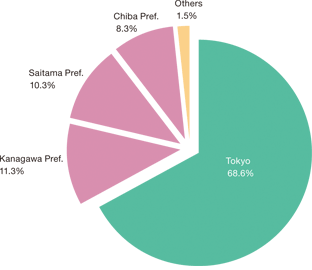TOKYO’S HISTORY, GEOGRAPHY, AND POPULATION
Population of Tokyo
Population Summary
As of October 1, 2015, the population of Tokyo is estimated to be 13.491 million, or about 11% of Japan’s total population, and it has the largest population among all the 47 prefectures.
At 2,191 square kilometers, the area of Tokyo is 0.6% of the total area of Japan. With a population density of 6,158 persons per square kilometer, Tokyo is the most densely populated prefecture in Japan.
The ward area is home to 9.241 million persons, the Tama area, 4.223 million, and the Islands, 26,000.
Tokyo has 6.946 million households, with an average 1.94 persons per household. The number of foreign residents according to the basic resident register is 440,000 as of October 1, 2015.
Trends in Population in Tokyo

- Sources:
- Statistics Division, Bureau of General Affairs, TMG; “Population of Tokyo (estimates)”
Ministry of Internal Affairs and Communications; “Population Census”
Population Change
The population migration between Tokyo and other prefectures in 2014 showed 405,000 persons moving into Tokyo while 331,000 persons moved out, for a net social increase of 73,000 persons.
With the exception of 1985, there was a prevailing trend of out-migration exceeding in-migration since 1967, until a net social increase was seen for the first time in 12 years in 1997. 2014 again showed a net increase.
Looking at the migration between Tokyo and the three adjacent prefectures (Saitama, Chiba, and Kanagawa prefectures), 181,000 people came into Tokyo while 172,000 moved out.
Following the peak net natural increase of 182,000 in 1968, Tokyo experienced a slowing of population growth and marked its first population decline in 2012. During 2014, there was a net natural decrease of 125, with about 111,000 births and 111,000 deaths.
Demographic Composition by Age
According to the National Census, as of October 1, 2010, the population of Tokyo was 13.159 million (Statistics Bureau, Ministry of Internal Affairs and Communications). This number was divided into three age categories: child population (ages 0 - 14) at 1.477 million; the working-age population (ages 15 - 64) at 8.85 million; and the aged population (ages 65 and over) at 2.642 million. These figures are 11.4%, 68.2% and 20.4%, respectively, of the overall population.
The percentage of aged persons exceeded the United Nations standard of 14% for an “aged society” in 1998, and is now approaching the level of 21%, signifying a “super-aged society.”
Labor Force Population
As of October 1, 2010, the population aged 15 years and older was 11.492 million persons, of whom 6.013 million were employed and 375,000 fully unemployed within a total labor force population of 6.387 million persons.
Demographic Composition by Industry
According to the National Census of 2010, when employed persons were viewed by the three industrial groups, 22,000 persons (0.4%) were employed in the primary industry of agriculture, forestry, and fisheries; 0.912 million (15.2%) in the secondary industry of mining, construction, and manufacturing; and 4.256 million (70.8%) in the tertiary industry of commerce, transportation, communication, and services.
Demographic Composition by Occupation
According to the National Census of 2010, when employed persons were viewed by the four employment groups, 23,000 persons (0.4%) were employed in agriculture, forestry, and fisheries; 1.064 million (17.7%) in manufacturing and transportation-related occupations; 1.575 million (26.2%) in sales and services; and 2.542 million (42.3%) in clerical, technical, and management occupations.
Daytime and Nighttime Population
The National Census in 2010 lists the daytime population of Tokyo as 15.576 million people, which is 2.417 million more than the nighttime population figure of 13.159 million. This makes the daytime population 1.2 times more than that of the nighttime population; the daytime population index is 118.4 against the nighttime population taken at 100. This difference is caused by the population of commuting workers and students, constituting a daytime influx from mainly the three neighboring prefectures of Saitama, Chiba, and Kanagawa.
The daytime population, broken down by area, shows 11.711 million in the ward area, 3.837 million in the Tama area, and 28,000 persons in the islands. The daytime population indices for these three areas are 130.9, 91.7, and 100.7, respectively, and the ward figure is noticeably higher. Remarkably, the three central wards—Chiyoda, Chuo and Minato—have an index of 616.3 (a nighttime population of 375,000 persons and a daytime population of 2.311 million), making their daytime population more than six times the nighttime population.
Changes in the metropolis since 1965 show that in the period up to 2010, while the nighttime population increased by 2.290 million (21.1%), the daytime population had a much greater increase of 3.825 million (32.6%), bringing about a large imbalance.
Changes in Population Composition by Three Age Groups
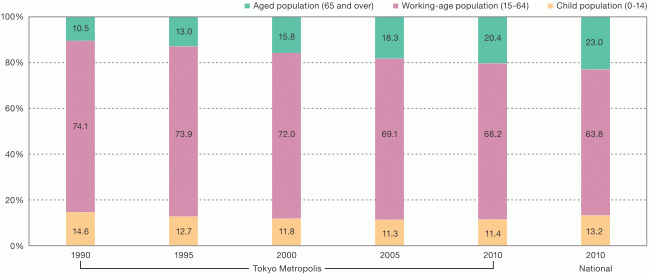
The denominators (total population) from 1995 to 2005 used to calculate the percentages include persons of unknown age.
Changes in Tokyo's Daytime and Nighttime Populations
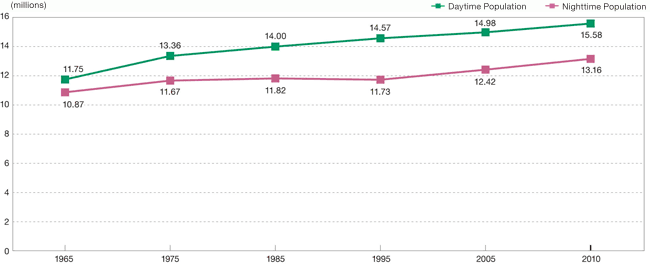
Both daytime and nighttime populations exclude persons whose ages are unknown.
Source:Statistics Division, Bureau of General Affairs, TMG; “Daytime Population in Tokyo”
Trends in Breakdown of Employed Persons by Three Industry Sectors
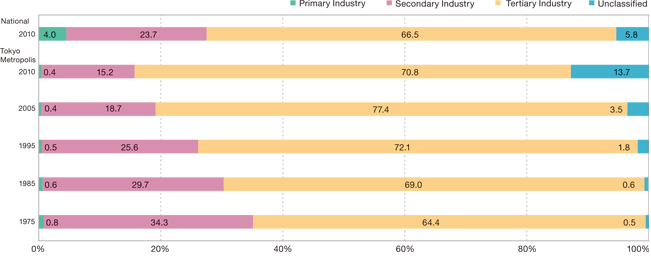
- Source:
- Statistics Bureau, Ministry of Internal Affairs and Communications; “Population Census”
Population Commuting into Tokyo
Metropolis by Prefecture (2010)
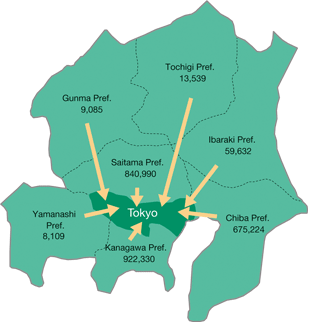
The figures indicate the number of workers who live in neighboring prefectures and commute into Tokyo.
Source: Ministry of Internal Affairs and Communications; “Population Census”
Proportion of Workers in Tokyo
Metropolis by Place of Residence (2010)
